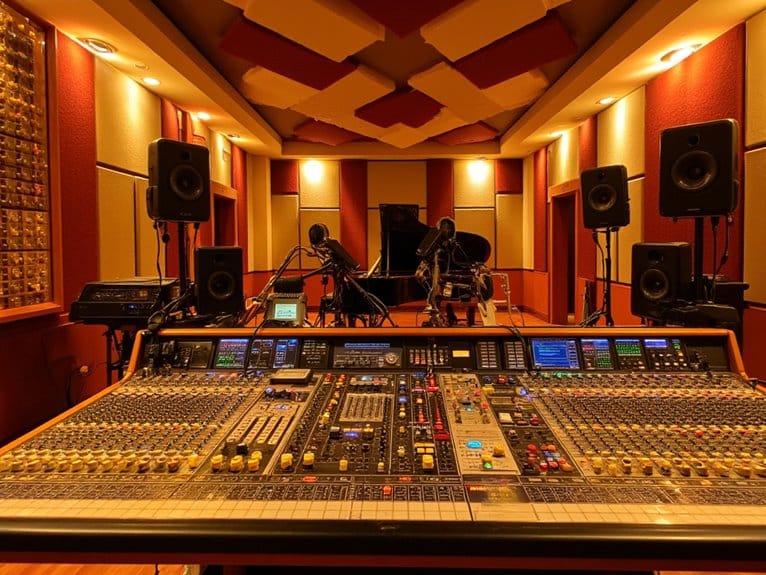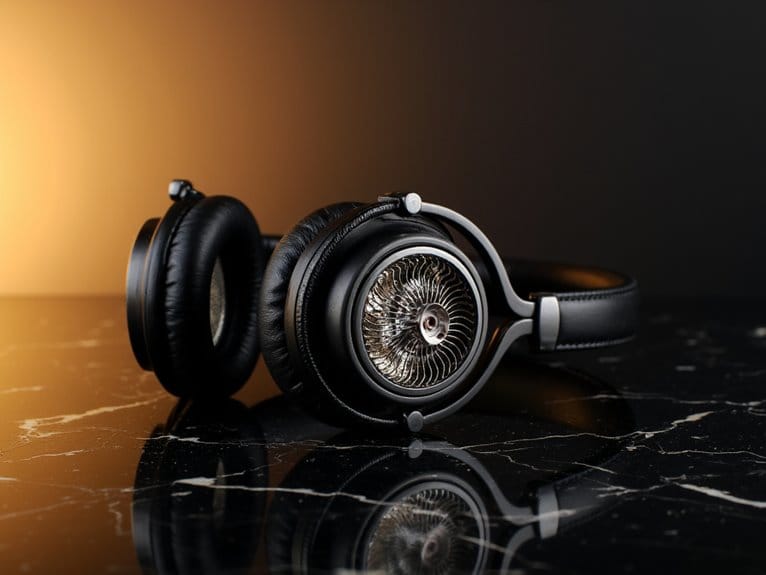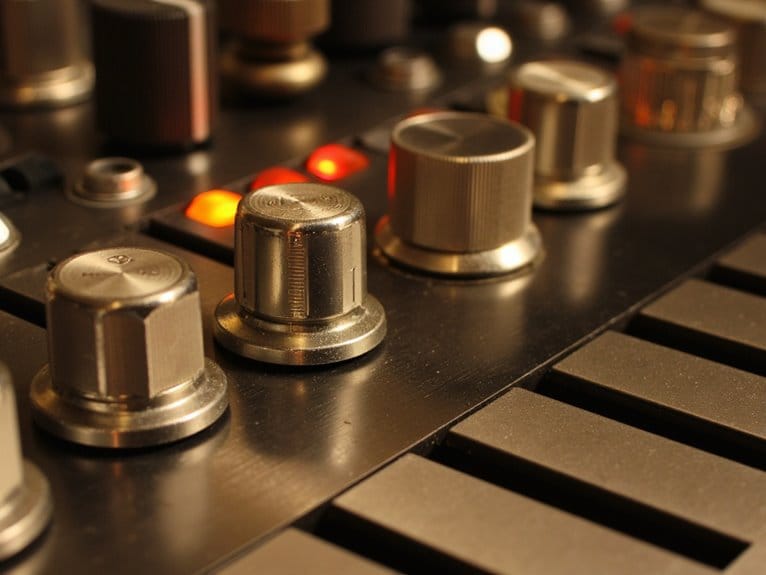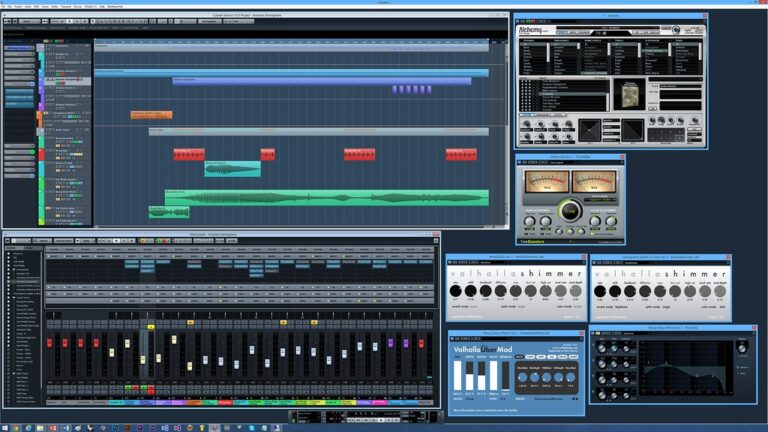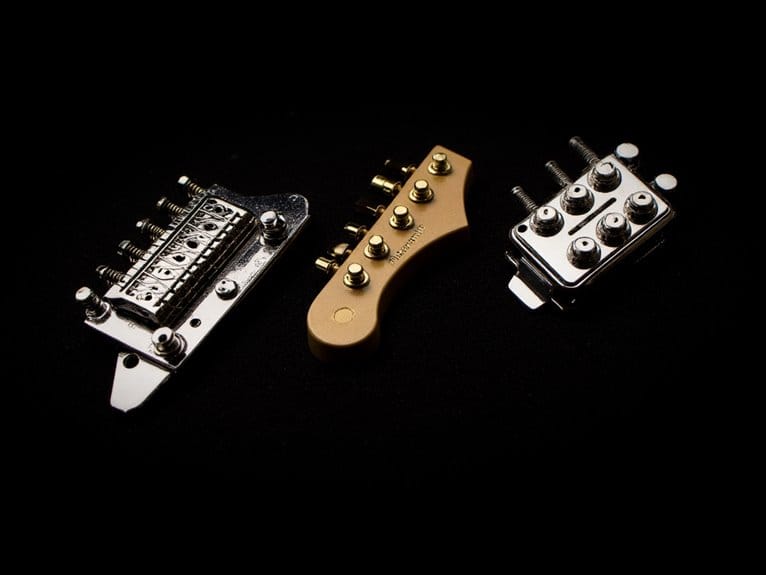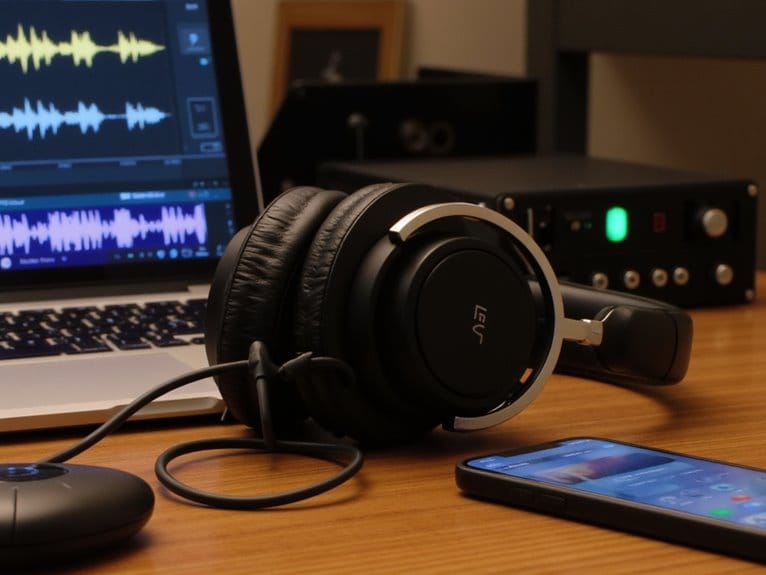Professional Audio Standards and Best Practices
You’ll need to follow key professional audio standards to achieve broadcast-quality results, starting with AES/EBU digital transmission for balanced XLR connections over long runs, maintaining -14 LUFS for streaming platforms, and calibrating monitors to 79 dB SPL using pink noise. I’ve found that 24-bit recording depth provides ideal dynamic range while 48 kHz sample rates work best for video content. The technical foundations we’ll explore next reveal why these specifications matter for your productions.
We are supported by our audience. When you purchase through links on our site, we may earn an affiliate commission, at no extra cost for you. Learn more.
Notable Insights
- AES3 (AES/EBU) standard enables professional digital audio transmission with 24-bit depth, 192 kHz sample rates, and reliable error correction.
- Balanced XLR cables reject electromagnetic interference using dual signal wires with opposite polarity for superior noise cancellation.
- LUFS measurement ensures broadcast compliance with platform-specific loudness standards like Spotify’s -14 LUFS and Apple’s -16 LUFS targets.
- Professional installations require balanced connections for cable runs exceeding 25-30 feet to maintain signal integrity and quality.
- AVIXA D401.01:2023 standard establishes documentation protocols and responsibilities across all professional AV project phases for stakeholder clarity.
Digital Audio Transmission Standards for Professional Environments
When you’re working with professional audio equipment, you’ll quickly discover that AES3 (also known as AES/EBU) has become the backbone of digital audio transmission in studios, broadcasting facilities, and live sound installations worldwide.
This standard defines how two channels of PCM audio data travel serially through balanced XLR connections, maintaining 110-ohm impedance while supporting impressive cable runs over 100 meters without signal degradation.
What makes AES3 particularly valuable is its robust digital format compatibility, supporting bit depths up to 24-bit and sample rates reaching 192 kHz.
The standard includes thorough channel status information and user data, plus built-in error detection and correction features that guarantee reliable transmission.
For professional audio interoperability, AES3’s widespread adoption means you can confidently connect equipment from different manufacturers while maintaining consistent signal integrity.
Aes/Ebu Vs S/Pdif: Choosing the Right Digital Audio Format
Although both AES/EBU and S/PDIF transmit the same fundamental digital audio data, I’ve found that choosing between these formats can make or break your signal chain’s performance, especially when you’re dealing with demanding professional applications or finicky consumer setups.
AES/EBU advantages include superior signal quality through balanced 110Ω cables with XLR connectors, while S/PDIF limitations become apparent in longer cable runs where jitter issues plague unbalanced connections.
| Feature | AES/EBU | S/PDIF |
|---|---|---|
| Cable Type | Balanced 110Ω XLR | Unbalanced 75Ω RCA/Optical |
| Distance | Professional long runs | Consumer short distances |
| Interference | Excellent rejection | Susceptible to noise |
| Applications | Studio/broadcast | Home audio systems |
| Cost | Higher professional grade | Consumer-friendly pricing |
The key difference lies in how AES/EBU uses balanced connections with three conductors that actively cancel interference through common-mode rejection, making them ideal for environments with high electromagnetic interference.
For professional use requiring interface compatibility and reliable system integration, AES/EBU proves indispensable, whereas consumer applications favor S/PDIF’s simplicity despite inherent audio formats constraints. When selecting audio interfaces for your digital setup, prioritize 24-bit resolution and adequate sampling rates to ensure your chosen format delivers optimal sound quality.
AVIXA Framework for Professional AV System Documentation
When you’re working with professional AV systems, you’ll quickly discover that proper documentation isn’t just paperwork—it’s the backbone that keeps complex projects from becoming expensive disasters.
AVIXA’s D401.01:2023 standard establishes clear protocols for who creates which documents, how you track their delivery through project phases, and what responsibilities each team member carries throughout the process.
I’ve seen too many installations fail not because of technical issues, but because stakeholders couldn’t agree on what was actually specified, making these documentation frameworks essential for protecting both your project timeline and your professional reputation.
Documentation Creation Standards
Since I’ve spent countless hours wrestling with poorly documented AV projects that turned into expensive nightmares, I can’t emphasize enough how critical the AVIXA Framework for Professional AV System Documentation has become in our industry.
The framework’s documentation creation standards establish clear documentation responsibilities across project phases, ensuring you’ll never wonder who’s supposed to create what deliverables.
These standards define specific documentation roles for AV designers, engineers, and installation teams, creating accountability that prevents the finger-pointing I’ve witnessed too many times.
You’ll find that proper role assignment covers everything from initial system design drawings to final as-built documentation, including thorough component descriptions, installation details, and verification reports that actually mean something when troubleshooting occurs.
Delivery Tracking Methods
Creating documentation is only half the battle—you need robust delivery tracking methods to secure those carefully crafted deliverables actually reach the right people at the right time, which is where the AVIXA D401.01 standard becomes your project management lifeline.
I’ve found that effective delivery accuracy depends on these four essential tracking methods:
- Digital tracking systems that maintain real-time status updates and automated notifications for upcoming deadlines
- Detailed delivery logs documenting document types, versions, recipients, and confirmation timestamps for complete accountability
- Version control protocols preventing document discrepancies while securing teams always use current documentation during project phases
- Audit trail capabilities enabling retrospective review of delivery timelines and identifying bottlenecks before they derail progress
These methods secure documentation compliance while supporting transparent communication between stakeholders throughout your project lifecycle.
Responsibility Assignment Protocols
Although document creation and tracking form the operational backbone of AV projects, establishing clear responsibility assignment protocols represents the strategic foundation that determines whether your documentation efforts will succeed or stumble into costly confusion.
AVIXA’s ANSI/AVIXA D401.01:2023 standard creates frameworks that assign specific documentation tasks to designers, installers, integrators, and clients based on project phases and expertise levels. You’ll find that responsibility assignment eliminates overlaps between team members while ensuring no vital documentation falls through procedural cracks.
Each phase—programming, design, construction, and verification—demands distinct deliverables with designated responsible parties who must verify documentation accuracy before stakeholder delivery. This systematic approach prevents the all-too-common scenario where everyone assumes someone else handled essential documentation requirements.
Signal Integrity and Balanced Cable Implementation
You’ll find that XLR cables form the backbone of professional audio systems because they employ balanced connections that actively reject electromagnetic interference, delivering clean signals even across lengthy cable runs in demanding studio environments.
When you’re weighing balanced versus unbalanced systems, the choice becomes clear once you consider that balanced configurations use two signal wires plus ground to cancel out noise, while unbalanced setups rely on a single signal wire that’s vulnerable to hum, buzz, and interference from nearby equipment.
I’ve witnessed countless scenarios where upgrading from unbalanced RCA or TS connections to balanced XLR or TRS cables immediately transformed noisy, problematic audio chains into pristine, professional-grade signal paths.
Professional mixing consoles equipped with multiple XLR inputs and 48V phantom power provide the essential foundation for capturing studio-quality recordings while maintaining the signal integrity that balanced connections deliver.
Signal attenuation becomes noticeable around the 20-foot mark with unbalanced connections, making balanced cables essential for any serious studio setup where cable runs exceed this critical distance.
XLR Cable Noise Reduction
When I first started working with professional audio equipment, I quickly learned that three simple wires inside an XLR cable can make the difference between crystal-clear recordings and frustrating background noise that’ll drive you absolutely crazy.
The genius lies in how balanced XLR design works, where two signal wires carry identical audio with opposite polarity, while any electromagnetic interference affects both wires equally and gets canceled out at the receiving end.
Here’s what makes XLR cables so effective at noise reduction:
- Cable shielding techniques using braided or foil layers block external electromagnetic and radio frequency interference
- Twisted pair advantages create geometric symmetry that enhances noise rejection capabilities
- Secure locking connectors prevent intermittent connections that introduce unwanted artifacts
- Professional-grade construction maintains signal integrity over extended cable runs in demanding environments
Multiple shielding layers using oxygen-free copper cores and aluminum foil provide effective EMI and RFI protection that can block up to 99% of interference.
This balanced approach ensures microphones maintain their intended frequency response characteristics without degradation from external interference that could alter the original sound capture.
Balanced Vs Unbalanced Systems
Since discovering the fundamental differences between balanced and unbalanced audio systems early in my career, I’ve witnessed countless engineers struggle with signal degradation issues that could’ve been avoided with proper cable selection.
You’ll find that balanced cable advantages become immediately apparent when dealing with longer runs, typically exceeding 25-30 feet, where noise rejection through common-mode cancellation maintains pristine signal integrity. The dual-conductor design, carrying identical signals with opposite polarity, allows receiving equipment to eliminate electromagnetic interference effectively.
Conversely, unbalanced cable drawbacks manifest as humming, buzzing, and signal loss, particularly in electromagnetically noisy environments where professional setups operate. While unbalanced connections work adequately for short consumer applications under ten feet, balanced systems provide 6-10 dB higher output levels, superior signal-to-noise ratios, and reliable performance across extended distances.
Professional microphones typically utilize low impedance designs ranging from 150-600 ohms, which offer superior noise immunity and dynamic range compared to high-impedance alternatives that are more susceptible to interference.
Maintaining proper impedance matching throughout your signal chain ensures these balanced system advantages aren’t compromised by signal loss or unwanted noise that can degrade your carefully configured setup.
LUFS Measurement for Broadcast and Streaming Compliance
If you’ve ever wondered why some songs sound drastically louder than others when shuffling through your playlist, you’re witnessing the exact problem that LUFS measurement was designed to solve.
LUFS standards guarantee broadcast consistency and streaming loudness through sophisticated loudness calibration that measures perceived volume rather than just peak levels.
Modern audio normalization relies on four key LUFS metrics for mastering techniques:
- Integrated loudness – measures overall track average for compliance regulations
- Dynamic range – captures difference between loudest and quietest moments
- Short-term LUFS – identifies brief loudness fluctuations within segments
- Momentary adjustments – provides fine-tuning through 400-millisecond measurement windows
Platforms like Spotify target -14 LUFS integrated, while Apple Podcasts enforces -16 LUFS, guaranteeing your content maintains intended dynamics without automatic volume compensation.
Audio Description Services and Accessibility Standards
Audio description services transform visual storytelling into accessible narratives, ensuring that viewers who are blind or have low vision can fully experience multimedia content through carefully crafted verbal descriptions of on-screen action, settings, and visual cues.
You’ll need to implement these services with precise timing, inserting concise narrations during natural pauses between dialogue without disrupting the original audio flow.
Compliance with Section 508 and ADA requirements isn’t optional—it’s mandatory for government agencies and increasingly expected across commercial platforms.
Your audio inclusion strategy should prioritize accurate, neutral descriptions that maintain consistency in tone and pacing while matching the program’s aesthetic.
Quality standards demand professional pronunciation, appropriate content prioritization, and seamless integration that enhances rather than interrupts the viewer experience for all audiences.
Sample Rate and Bit Depth Optimization Strategies
When you’re setting up your recording chain, you’ll need to make strategic decisions about sample rate selection, bit depth configuration, and format conversion strategies that’ll directly impact your final audio quality.
I’ve learned through years of studio work that these technical choices, while seemingly abstract, determine whether your recordings maintain their professional sheen or suffer from artifacts that can’t be fixed in post-production.
You’re fundamentally building the foundation for everything that follows, and getting these settings right from the start will save you countless hours of frustration later.
Sample Rate Selection
Selecting the ideal sample rate for your audio project represents one of the most fundamental decisions you’ll make in the production pipeline, directly influencing everything from file sizes and processing requirements to final output quality and compatibility.
Understanding sample rate effects on your workflow helps you balance technical excellence with practical constraints, while choosing suitable sample rates guarantees your audio meets industry expectations without wasting resources.
Consider these key factors when determining your project’s sample rate:
- Target medium – streaming platforms typically use 44.1 kHz, while film requires 48 kHz
- Processing overhead – higher rates demand considerably more CPU power and storage space
- Downsampling math – 88.2 kHz converts more cleanly to 44.1 kHz than 96 kHz does
- Client expectations – professional mastering often justifies 96 kHz or 192 kHz rates
Bit Depth Configuration
While sample rate determines how often your digital audio system captures sound waves, bit depth controls how precisely it measures the amplitude of each sample, and honestly, I’ve seen more projects suffer from poor bit depth decisions than almost any other technical misstep. Your bit depth configuration directly impacts dynamic range, noise floor, and overall recording quality throughout your production workflow.
| Bit Depth | Dynamic Range | Best Use Case |
|---|---|---|
| 16-bit | 96 dB | Final distribution, streaming |
| 24-bit | 144 dB | Professional recording, mixing |
| 32-bit float | Unlimited headroom | DAW processing, mastering |
I recommend 24-bit for recording sessions, providing superior audio fidelity and editing flexibility while maintaining production consistency. The improved headroom management and signal processing capabilities justify the minimal storage increase over 16-bit formats, especially when using floating point formats during post-production. Higher bit depths minimize quantization errors, enhancing sound clarity and allowing for capturing subtle dynamics between soft and loud sounds.
Format Conversion Strategies
Although many engineers treat format conversion as an afterthought, I’ve learned that strategic sample rate and bit depth optimization can make or break your final audio quality, requiring careful planning from the initial recording session through final delivery.
Your conversion workflow strategies should follow these sample rate considerations:
- Match your recording format to final delivery – Record at 48 kHz for video work, 44.1 kHz for music streaming
- Use high-quality resampling algorithms – Polyphase filters and sinc interpolation prevent artifacts during rate changes
- Minimize conversion steps – Each format change introduces potential quality loss and processing overhead
- Plan your mastering chain early – Consistent sample rates throughout production reduce cumulative degradation
I’ve found that oversampling beyond your target format wastes resources without audible benefits, so you’ll want to balance technical specs against practical workflow efficiency.
Professional Monitoring and Calibration Protocols
Because I’ve spent countless hours in studios where engineers argued about monitor levels while their mixes translated poorly to other systems, I can tell you that proper monitoring calibration isn’t just technical nitpicking—it’s the foundation that separates professional-sounding mixes from amateur ones.
Effective monitoring techniques start with setting your speakers to 79 dB SPL using pink noise and C-weighting, which establishes the reference point that professional facilities worldwide rely on.
Your calibration tools should include a quality SPL meter, since most DAWs lack built-in calibrated meters that translate digital levels to actual sound pressure.
The magic happens at -20 dBFS operating levels, where you maintain proper headroom while working within ideal Fletcher-Munson curves, ensuring your frequency perception remains accurate throughout long mixing sessions.
Error Detection and Correction in Digital Audio Systems
The invisible guardians of your digital audio chain work tirelessly behind the scenes, detecting and correcting data corruption that would otherwise turn your pristine recordings into unlistenable static.
After decades of watching engineers panic over mysterious dropouts that vanished after a simple cable swap, I’ve learned that understanding these error correction systems isn’t optional—it’s essential for anyone serious about audio quality.
Your system employs sophisticated error handling strategies through multiple detection layers:
- Cyclic Redundancy Check (CRC) calculations verify data integrity using mathematical checksums
- Cross-Interleaved Reed-Solomon Coding spreads burst errors across multiple data blocks
- Checksum implementation catches corrupted packets before they reach your speakers
- Probabilistic detection methods use redundant copies to identify suspect data
These techniques work together seamlessly, ensuring your audio maintains professional standards.
Power Management and Sustainability in AV Installations
While error correction protects your audio signal’s integrity, power management determines whether your AV installation will drain your electricity budget or operate with the efficiency of a well-tuned machine.
After watching countless facilities struggle with skyrocketing energy costs because someone thought “bigger is always better” when speccing amplifiers, I’ve learned that sustainable power practices aren’t just environmental virtue signaling—they’re essential for long-term operational success.
Your amplifier should supply two to four times your speaker’s continuous power rating, providing 3-6 dB of headroom without wasteful over-provisioning.
Power sequencing prevents damaging current surges during startup, while energy monitoring through real-time voltage and amperage meters helps identify inefficient consumption patterns.
High-sensitivity speakers above 95 dB-SPL/watt/meter achieve desired levels with considerably less power, and digital amplification technologies typically offer superior efficiency compared to their analog counterparts.
Channel Configuration Standards for Surround Sound Systems
Power efficiency means nothing if you’re pumping that carefully conserved electricity through a surround sound system that’s configured like a garage band’s first attempt at speaker placement.
After years of walking into installations where someone decided the “more speakers everywhere” approach would magically create immersive audio, I can tell you that proper channel configuration isn’t just about having the right number of speakers—it’s about understanding how each channel’s precise placement creates the spatial illusion that transforms your living room into a concert hall or movie theater.
- Standard 5.1 configurations position front speakers at ±60 degrees with surrounds at 100-120 degrees for ideal sound localization
- Extended 7.1 systems add center-left/right channels 15 degrees off-center, enhancing spatial audio width
- Height-enabled configurations incorporate vertical speaker types above listener positioning for three-dimensional immersive experiences
- Audio calibration requires consistent surround formats and precise channel placement for proper sound field imaging
Latency Management in Live and Broadcast Audio
Every millisecond matters when you’re managing live broadcast audio, and after spending countless hours troubleshooting why a news anchor’s voice arrives three seconds after their lips stop moving, I can tell you that latency management isn’t just about having fast equipment—it’s about understanding how audio delay accumulates through every stage of your signal chain, from the microphone capsule to the viewer’s speakers.
| Component | Target Latency | Role |
|---|---|---|
| Hardware Encoders | <5ms | Compression processing |
| CDN Distribution | 50-200ms | Content delivery |
| Playback Buffer | 100-500ms | Stream stability |
Effective latency measurement techniques require monitoring each stage separately, while real time synchronization depends on adaptive protocols like WebRTC that dynamically adjust to network conditions, ensuring your audio stays locked to video regardless of transmission challenges. Professional broadcast environments require ASIO drivers to achieve the ultra-low round-trip latency necessary for live monitoring and real-time audio processing.
Frequently Asked Questions
What Are the Typical Costs for Implementing Professional Audio Standards Compliance?
You’ll face a cost breakdown ranging from $7,000 to $15,000 for initial compliance setup, including business registration ($5,000-$8,000) and mandatory insurance coverage.
The compliance challenges don’t stop there—you’re looking at annual premiums of $2,000-$7,000 for liability and equipment protection.
I’ve seen businesses underestimate ongoing costs like software updates and equipment calibration, which can add thousands yearly to your operational budget.
How Often Should Professional Audio Equipment Be Replaced or Upgraded?
You’ll want to plan your upgrade frequency around a 10-15 year review cycle for major components like consoles and amplifiers, though equipment lifespan varies considerably based on maintenance and usage conditions.
I’ve found that catastrophic failure or performance degradation typically triggers replacement more than arbitrary timelines, especially when heat, dust, and environmental factors accelerate wear on critical components like capacitors and drivers.
What Insurance Requirements Exist for Professional Audio Installations and Equipment?
You’ll need extensive liability coverage protecting against third-party injuries during installations, plus equipment protection covering theft, damage, and environmental hazards.
Most venues require proof of insurance before you can work, and I’ve found that specialized audio equipment policies offer better coverage than general business insurance.
High-value gear often needs detailed inventories and custom valuations to guarantee adequate protection limits.
Which Professional Audio Certifications Are Most Valuable for Career Advancement?
You’ll find the most valuable audio certifications for career advancement include Certified Audio Engineer (CEA) from SBE, which provides broad industry recognition, and Avid’s Pro Tools certification programs that demonstrate proficiency in industry-standard software.
These certification programs offer significant career benefits by validating your technical competency to employers.
I’d recommend prioritizing certifications that align with your specialization—whether broadcast, music production, or live sound engineering.
How Do You Handle Audio Standards Compliance Across Different International Markets?
You’ll need to conduct thorough audio regulations comparison early in your product development cycle, identifying specific requirements like FCC certification in the US, CE marking in Europe, and regional audio standards across Asia.
I recommend working with compliance experts who understand each market’s unique safety, environmental, and performance mandates, since maneuvering RoHS directives, ISO certifications, and cultural sensitivities requires specialized knowledge that’ll save you significant time and costly market entry delays.
On a final note
You’ll find that mastering these professional audio standards isn’t just about technical compliance—it’s about delivering consistent, reliable results that your clients can trust. Whether you’re implementing AES/EBU protocols, managing LUFS levels for broadcast, or configuring multichannel surround systems, these frameworks provide the foundation for professional-grade installations. Don’t overlook power management and sustainability considerations, as they’re increasingly critical for modern AV deployments that’ll stand the test of time.

